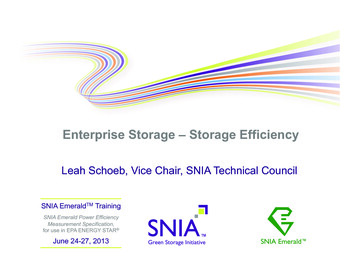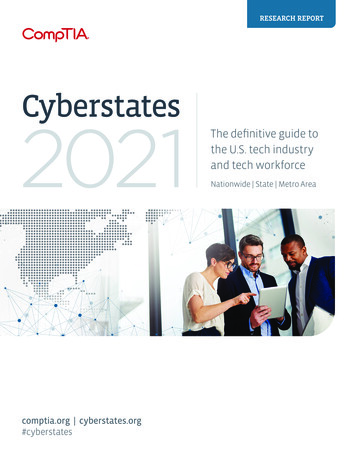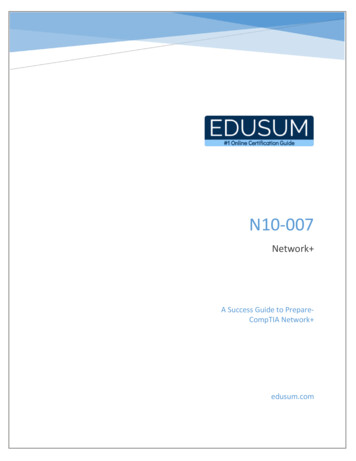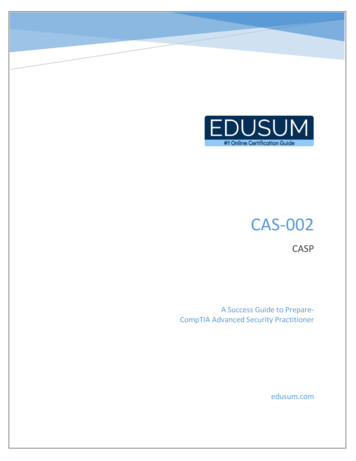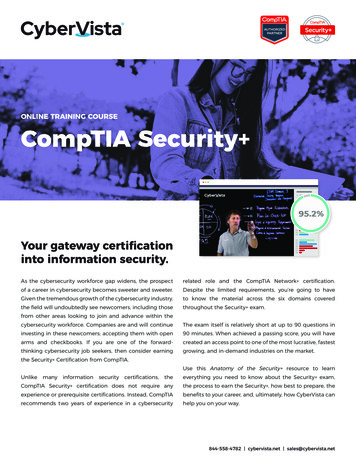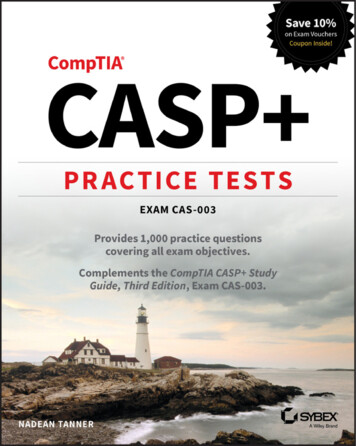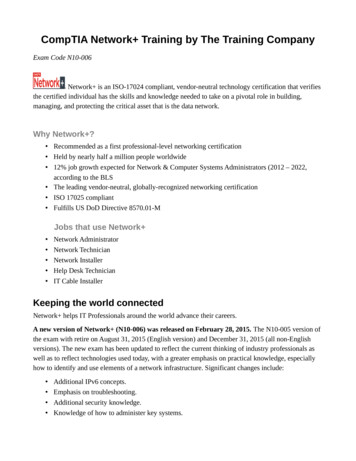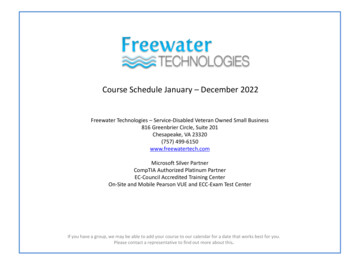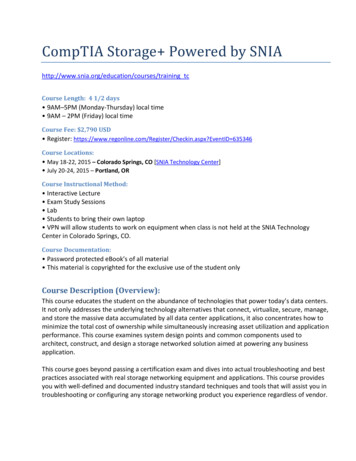
Transcription
CompTIA Storage Powered by SNIAhttp://www.snia.org/education/courses/training tcCourse Length: 4 1/2 days 9AM–5PM (Monday-Thursday) local time 9AM – 2PM (Friday) local timeCourse Fee: 2,790 USD Register: entID 635346Course Locations: May 18-22, 2015 – Colorado Springs, CO [SNIA Technology Center] July 20-24, 2015 – Portland, ORCourse Instructional Method: Interactive Lecture Exam Study Sessions Lab Students to bring their own laptop VPN will allow students to work on equipment when class is not held at the SNIA TechnologyCenter in Colorado Springs, CO.Course Documentation: Password protected eBook’s of all material This material is copyrighted for the exclusive use of the student onlyCourse Description (Overview):This course educates the student on the abundance of technologies that power today’s data centers.It not only addresses the underlying technology alternatives that connect, virtualize, secure, manage,and store the massive data accumulated by all data center applications, it also concentrates how tominimize the total cost of ownership while simultaneously increasing asset utilization and applicationperformance. This course examines system design points and common components used toarchitect, construct, and design a storage networked solution aimed at powering any businessapplication.This course goes beyond passing a certification exam and dives into actual troubleshooting and bestpractices associated with real storage networking equipment and applications. This course providesyou with well-defined and documented industry standard techniques and tools that will assist you introubleshooting or configuring any storage networking product you experience regardless of vendor.
Course Descriptions – CompTIA Storage Certification Topics Course Introduction Certifications Basics- Basic Concepts Networks vs. Storage Capacity Network Links Storage Servers Network Devices DAS, NAS, SAN, FAN & Hybrids External vs. Internal SANs Blocks, Files & Objects Overview Storage–Storage Concepts Hard Disk Drive (HDD) Solid State Drive (SSD) Tape JBOD Storage Arrays LUN Presentation LUN Aggregation Dynamic LUN Expansion Thick & Thin Provisioning Persistent Binding RAID levels Combined RAID Levels MAID– Storage Technologies SCSI Storage Overview P-SCSI SAS SATA Networks–Fibre Channel Technologies FC Overview FC Topologies FC Names & Addresses FC Names & Addresses NPIV
FC Architecture FC Architecture Overview FC-0 FC-1 FC-2 FC-Services FC-3 FC-4 SCSI & IP–Fibre Channel Components HBAs and CNAs FC Hubs & Loop Switches FC Bridges, Routers & Gateways FC Fabric Switches Switches Switch Fabric Design Switch Fabric Pathing Switch Fabric Zoning & LUN Masking Switch Fabric Router Switch Virtual Fabrics FC Animations–IP Storage & iSCSI Technologies Storage Networking & IP IP over FC (IPFC) Internet Fibre Channel Protocol (iFCP) Metropolitan Fibre Channel Protocol (mFCP) Fibre Channel over IP (FCIP) Internet SCSI Protocol (iSCSI) Data Center Networks –Converged Enhanced Ethernet and Data Center Bridging (CEE & DCB) Data Center Networks –Fibre Channel over Ethernet (FCoE)–Networking Concepts Introduction to Networking What is a layered stack? Data Structures Physical Transport Networks Simplex and Duplex Network Models Circuit & Packet Switch Bus, Loop & Expanse Connection-Oriented vs. Connectionless Bit Rate, Bandwidth, Latency and Throughput Ports and PHYs Names & Addresses Flow Control Segmentation & Offload
–System Interface Technologies PCIe InfiniBand–Storage Network Performance Performance Prelude Flow Control FC Arbitrated Loop FC Fabric Fragmentation Tools–Troubleshooting Storage Networking Troubleshooting Storage Networking Environmental Storage Networking Troubleshooting Tools Applications–Data Protection Backup & Recovery Overview Technologies Overview Methods & Levels Snapshots & Replication Networking Virtual Tape Library (VTL) Continuous Data Protection (CDP) Data DeDuplication–Information Lifecycle Management (ILM)–Tiered Storage–Storage Virtualization–Storage Management–Continuity Management & High Availability–Storage Networking Security–Storage Networking Applications–Green Storage–Green Data–Cloud Storage–Storage Network File Systems Additional Information–Storage Networking Resources Futures Web Links Practice Tests
Storage Network Certifications:This course is explicitly designed to prepare the student for many vendor neutral and vendor specificStorage Network Certification Programs including:CompTIA CompTIA Storage Powered by SNIA exam leading to the CompTIA Storage Powered by SNIAcredentialStorage Networking Industry Association (SNIA) Storage Networking Storage Management & Administration exam leading to the SNIACertified Storage Engineer (SCSE) credentialSNIA Architect – Assessment Planning & Design exam leading to the SNIA Certified StorageArchitect (SCSA) credentialSNIA Certified Storage Networking – Expert (SCSN-E) credentialCourse Objectives (What you will learn):What’s exciting about it, why it’s important, where it’s going? Learn from an expert storage networking technologist with over 20 years of experience This detailed seminar includes all of the topics needed to understand Storage Networkingconcepts and solutions including Ethernet, Fibre Channel, Serial Attached SCSI, SATA, iSCSI, FCover Ethernet, InfiniBand, and PCI Express technologies. Students will gain a fundamental understanding of the entire Storage Networking industryand all the components that enable today’s and tomorrow’s Data Centers. Students will gain a fundamental understanding of the how tiered storage enables costeffective Data Centers and all the standards and associations that drive today’s StorageNetworking technologies (FCIA, STA, SNIA, etc.). Topics include Storage Fundamentals which detail SCSI protocol; disk, tape, optical, and Flashdevices, file system concepts, RAID (all levels) and JBOD, as well as DAS, NAS and SANcomponents, configurations, and protocols. This seminar also details practical and typical SAN Applications including consolidation,backup/restore, and disaster recovery with key insights into issues facing today’s ITdepartments including interoperability, management, and defining storage requirements suchas capacity planning, high availability, and security. Learn how emerging technologies and can impact future data center designsAudience (Who should attend): This seminar is recommended for students needing a broad deep knowledge andunderstanding of Storage and Storage networking concepts, applications, and technologies.All storage network practitionersAnyone who designs, implements, manages, specifies or selects Storage NetworkingtechnologiesIS/IT technical staff and managers, product developers, systems integrators, systemsengineers and technical marketing personnel
Product and project teams that are involved with applications, systems, storage and end userswill benefit from this course.Developers, integrators, engineers, administrators, managers, marketing personnel andothers with a need for an understanding of Storage Networking will find this seminarextremely informative.Anyone involved in storage or data communications networking will understand thesimilarities and differences between thee environments and will be in position to take on thechallenges introduced by Storage Networking.Job Roles:This course content and technical level are targeted for professionals working in roles similar to thefollowing: Product/Application/Service Development Product/Application/Service Support Customer Management & Technical Personnel Sales/Pre Sales/Marketing & Systems Engineers Technical ProjectPrerequisites:Computer technology degree or equivalent experienceUnderstanding of computer theory and technology (i.e. CPU, server, storage, network, switch,RAM, etc.).
Data Center Networks -Converged Enhanced Ethernet and Data Center Bridging (CEE & DCB) Data Center Networks -Fibre Channel over Ethernet (FCoE) -Networking Concepts . effective Data Centers and all the standards and associations that drive today's Storage Networking technologies (FCIA, STA, SNIA, etc.).

